
by Larry Williams | Aug 14, 2020
Oleander caterpillars, which are active on some oleanders during summer, can provide a number of gardening lessons.
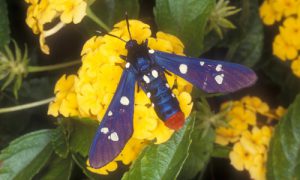
Oleander caterpillar moth on lantana flower. Photo credit: James Castner, UF
The adult moth is striking in appearance. The bluish to purplish moth has white dots on its black wings. The moths resemble wasps as they fly in and around oleander shrubs.
It’s the orange caterpillars with black spots and black hairs that cause problems for some gardeners.
Caterpillars are the larval stage of butterflies and moths. In order to enjoy watching butterflies and moths feeding on the nectar of flowers, some of the caterpillars must survive to become adult butterflies and moths. This is lesson number one.
Oleander caterpillars usually only feed on oleander plants. Oleanders are native to areas of Europe and Asia. This is lesson number two.
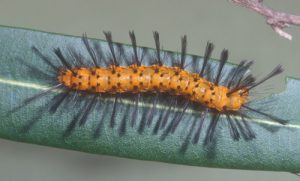
Oleander caterpillar, Photo credit: Paul Choate, UF
Oleander caterpillars benefit by us planting their food source in Florida.
This relationship between pest and plant is referred to as the key plant, key pest concept. Some other examples include St. Augustinegrass and chinch bugs, gardenias and whiteflies, crape myrtles and crape myrtle aphids, azaleas and azalea caterpillars, camellias and tea scale, roses and black spot, pecans and pecan scab, squash and squash vine borers.
Understanding this concept can be helpful in designing a “low maintenance” landscape.
When you plant roses, you plant everything that goes with roses, including the time and money required to maintain them. This applies to St. Augustinegrass, pecan trees, squash and oleanders. This is lesson number three.
Oleander caterpillars can temporarily damage the appearance of oleanders. But they cause no long-term damage for the plant. This is lesson number four. The damage is aesthetic. Oleander caterpillars can consume great numbers of leaves. However, if the plant is otherwise healthy, new leaves will be produced and the plant will continue to grow. The damage is temporary; there will be no evidence the plant ever had a problem.
To spray or not to spray for oleander caterpillars has to do with a person’s tolerance level.
If you can’t tolerate having oleander caterpillars around and the temporary aesthetic damage they cause, consider the use of Bacillus thuringiensis. It is sold under a number of brand names and many times is referred to as Bt. This bacterium only controls caterpillars so it is friendlier for the beneficial insects. When using any pesticide, always follow the label directions and precautions.
Here are links to UF/IFAS Extension publications with more info.

by Julie McConnell | Jul 16, 2020
We hope you were able to join us for Gardening in the Panhandle LIVE! Butterfly Gardening on July 9th to learn about attracting butterflies to your Florida gardens. As promised, we have compiled a list of butterfly resources that we talked about during the webinar and a few extra that we didn’t have time to cover.
If you were not able to join us live, you can still watch the videos on Facebook or YouTube
Click on the topic of interest for links to resources:
Don’t forget to tune in for our next Gardening in the Panhandle LIVE! on July 23rd for Prepping for the Fall Garden. Register for that webinar on Zoom or Follow our Facebook Event for updates.
For a full list of upcoming webinars visit Gardening in the Panhandle: LIVE!
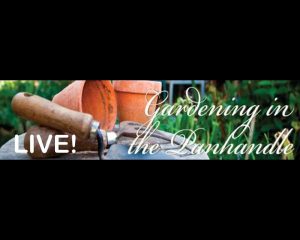

by Ray Bodrey | Jul 1, 2020
Sunflowers, Helianthus spp., are a great choice for gardeners who are looking for some cheerful color in their landscape. Here in Florida, we have the main ingredient for success, lots of sunshine!

‘Skyscraper’ Sunflower bloom. Photo courtesy of Ray Bodrey.
Sunflowers are short-lived annuals. The average time between planting and bloom is roughly 65 days. You can typically plant sunflowers in Florida beginning in late winter until early fall. Only the coldest months cause problems, and for most years that’s only November – January. Sunflowers can be planted almost anywhere there is full sun. The major selling point with sunflowers is, of course, the impressive blooms (figure 1). These yellow to sometimes orange or red-petaled flowers develop a central seed disc, with most variety’s flowers having approximately an 8” diameter.
When planting, you may choose to plant in narrow rows with close seed spacing in order to cull weaker plants later. A final row and seed spacing of 2’-3’ is recommended for full height and development of most varieties. However, you may also choose to plant in a bed, using a close pattern as seen in the photo below. In any event, sunflowers are easy to propagate by seed and are very low maintenance. Occasionally, powdery mildew and spittle bugs can be a nuisance. A general garden fungicide and insecticide will help if problems occur.
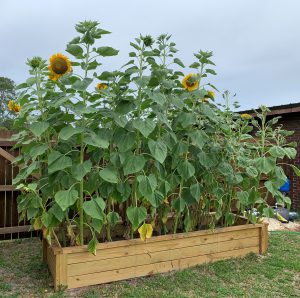
‘Skyscraper’ sunflowers planted on close spacing. Photo courtesy Ray Bodrey.
Sunflowers are available in many varieties, consisting of different color blooms and plant sizes. These sizes range from dwarf (1’-3’) to tall (10’-15’) varieties. You may wish to stake taller varieties at some point, as plants will tend to lean with no wind break in place. Here’s a few garden variety common names to look for: ‘Sunbright’, ‘Sonja’, ‘Sunrich Lemon’, ‘Sunrich Orange’ and ‘Autumn beauty’. Seed companies also have mixes available in packets. For tall plants, ‘Mammoth’ or ‘Skyscraper’ varieties will do the trick.
If you are fond of the sunflower bloom and looking for a groundcover, there are a couple of native perennials that fit this category. Beach sunflower, Helianthus debilis or swamp sunflower, Helianthus angustifolius, are groundcovers/ornamentals for landscapes and thrive in dry, hot climates and in a range of soil types. They also are great pollinator attractors.
For more information on growing sunflowers, contact your local county extension office.
Supporting information for this article and links to other publications on sunflowers can be found at the UF/IFAS Gardening Solutions website: https://gardeningsolutions.ifas.ufl.edu/plants/ornamentals/sunflowers.html
UF/IFAS Extension is an Equal Opportunity Institution.
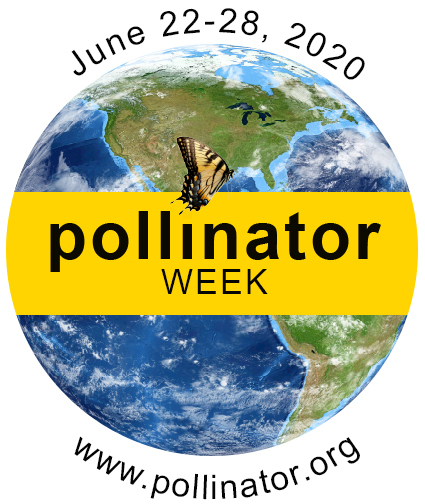
by Mary Salinas | Jun 23, 2020
For the 13th year we celebrate National Pollinator Week June 22-28 to bring awareness to the importance of our pollinators and the challenges they face. This is an opportunity to learn about ways to protect pollinators in our own landscapes. Every one of us can make a difference.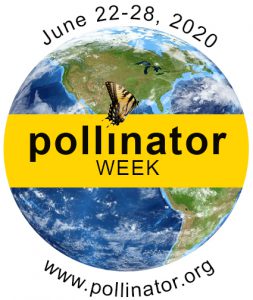
When we hear the word ‘pollinator’ most of us immediately think of honeybees. They are very important but there are so many other creatures that are important pollinators:
- Native bees – Florida alone has over 300 species of bees
- Hummingbirds – their long beaks can reach into long, tubular blooms
- Bats – they pollinate over 500 plants including banana, mango, and agave (used to make tequila)
- Beetles – considered to be a messy and minor pollinator; they pollinate the native paw paw
- Butterflies – a minor pollinator as most have long legs that keep them perched above the pollen
- Flies – pollinators of a variety of native plants
According to the USDA, 75% of flowering plants and about 35% of food crops around the globe rely on these animals for pollination. Without pollination, these plants would not reproduce or provide us food.
So, what can the average person do to make a difference?
- Plant what bees and butterflies love!
- Avoid using any insecticide unless it is absolutely necessary. Predators like assassin bugs, dragonflies and birds help to keep pests in check. Our songbirds rely on protein-rich insects (especially caterpillars) to feed their growing babies.
- Don’t treat areas where pollinators are visiting the flowers, whether in the lawn or the landscape beds.
- If you need to apply an insecticide to the lawn, mow first to remove the blooms from any weeds. Always follow the label instructions carefully.
- Avoid using a systemic insecticide on plants that bloom and attract pollinators. The insecticide can remain in plants for a long time.
Happy gardening during National Pollinator Week!
For more information:
Pollinator Partnership: Pollinator Week Activities
US Fish & Wildlife Pollinator Site
Native Insect Pollinators of the Southeastern United States brochure
Purdue University: Protecting Pollinators in Home Lawns and Landscapes
Minimizing Honey Bee Exposure to Pesticides

by Matthew Orwat | May 21, 2020

During these unusual times, the Gardening in the Panhandle Team has been working to bring you quality remote content through this online newsletter. In that vein, we have developed some new educational programming for our loyal readers.
We are providing one hour “Gardening in the Panhandle LIVE!” sessions on Zoom. These will occur during lunch hour, from 12:00 to 1:00 CDT. They will also be hosted on the Gardening in the Panhandle Facebook page and recorded if you can’t participate live. So, whether you are at home or work, bring your lunch up to your desk (or smart device) and enjoy Gardening in the Panhandle Live!
Click on the topic below to pre-register and submit your questions one week in advance.
Archived videos with closed captioning are linked to topics about one week after event airs.
The schedule follows below:
| Date |
Topic |
Panelists |
12-1pm CDT |
| May 28 |
Vegetables Gardening |
Matt Lollar, Evan Anderson, Matt Orwat |
|
| June 11 |
Lawn and Turfgrass |
Larry Williams, Daniel Leonard, Beth Bolles, Daniel Leonard |
|
| June 25 |
Ornamental & Landscape |
Sheila Dunning, Matt Lollar, Stephen Greer, Matt Orwat |
|
| July 9 |
Butterfly Gardening |
Mary Salinas, Julie McConnell, Beth Bolles |
|
| July 23 |
Prepping for the Fall Garden |
Matt Lollar, Danielle Sprague, Molly Jameson |
|
| August 6 |
Open Ended Q&A |
Mary Salinas, Evan Anderson, Beth Bolles, Matt Orwat |
|
| August 20 |
Gardening for Pollinators |
Dr. Gary Knox, Mark Tancig, Mary Salinas, Heather Kalaman |
|
| September 10 |
Fruiting Trees and Shrubs |
Dr. Xavier Martini, Danielle Sprague, Trevor Hylton |
|
| September 24 |
Gardening in Florida Soils |
Ray Bodrey, Matt Lollar, Pat Williams, Mark Tancig |
|
| October 1 |
Planting Trees and Shrubs |
Larry Williams, Ray Bodrey, Beth Bolles, Stephen Greer |
|
| October 15 |
Cool Season Gardening/Cold Protection |
Mary Salinas, Matt Lollar, Larry Williams |
|
| October 29 |
Landscape Pests (insect & disease) |
Danielle Sprague, Matt Orwat, Evan Anderson, Dr. Adam Dale |
|
| November 12 |
Selection and Care of Holiday Plants |
Matt Orwat, Larry Williams, Sheila Dunning, Stephen Greer |
|

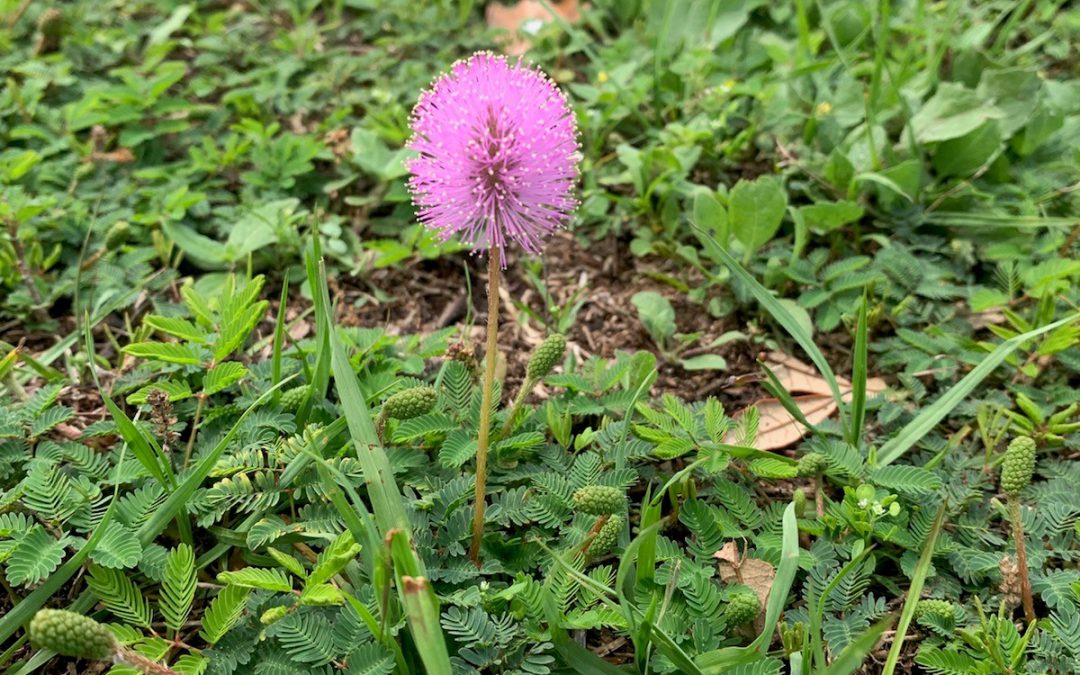
by Ray Bodrey | May 13, 2020
Powderpuff mimosa (Mimosa strigillosa), also called Sunshine Mimosa or Sensitive Plant, is an increasingly popular native plant for home and commercial landscape applications that offers a very show display of puffy pink flowers this time of year!
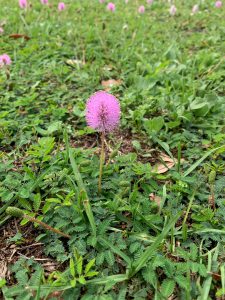
Powderpuff Mimosa, (Mimosa strigillosa). Photo courtesy of Ray Bodrey.
This Florida native, low-growing groundcover grows no more than eight inches in height, and that would be classified as an extremely vigorous stand. Powderpuff Mimosa is technically a perennial legume, meaning it doesn’t need any nitrogen fertilizer from gardeners.
The groundcover is appealing to the eye with its dark green fern-like leaves. Not an evergreen, the plants fall into a semi-dormant to dormant state during the fall and winter seasons. Powderpuff Mimosa is a very resilient groundcover as well, needing little irrigation, spreading quickly, and co-existing well with turfgrass. Just a few pots of this species transplanted should cover up to 300 square feet in a season. Although it spreads quickly, it can easily be pruned or mowed if it moves into unwanted areas.
Powderpuff mimosa is a great plant for erosion control due to its deep roots. These deep roots also allow for good levels of drought tolerance. There are very few insect or disease problems with this plant, other than the occasional caterpillar. It is a very wildlife and pollinator friendly plant, with honeybees, butterflies, deer, and more all finding it appealing. It’s even considered a livestock forage, as cattle find it palatable.
Looking to plant powderpuff mimosa in your landscape? Any area that gets mostly full sun is just fine. This plant is adapted to a wide range of soils, but particularly flourishes in well-drained, sandy loam soils. Be sure to water regularly, especially to ensure successful establishment in your landscape. Find this wonderful little plant at Florida native plant nurseries!
For more information contact the Gulf County Extension Office at 639-3200 or email at rbodrey@ufl.edu.
Supporting information for this article can be found in the UF/IFAS Extension website: https://gardeningsolutions.ifas.ufl.edu/plants/ornamentals/powderpuff-mimosa.html & USDA website: https://plants.usda.gov/plantguide/pdf/pg_mist2.pdf
UF/IFAS Extension is an Equal Opportunity Institution.














